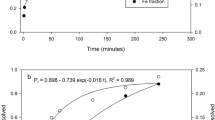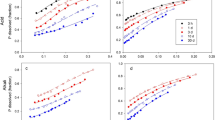Abstract
A test for phosphate rock (PR) reactivity has been developed based on a representation of certain fundamental properties of the rocks designated the Dissolution Rate Function. The function and properties have been shown to be those important in models of the dissolution rate of PRs in soil. The properties are size or mass distribution with size, solubility product, P content and particle density. In practice the solubility product is measured in terms of the P concentration attained in a standard solution, simulating that in an average soil with respect to pH, Ca and ionic strength.
The test compares favourably with those using citric and formic acids, using published results for the relative agronomic effectiveness of 11 PRs, both unground and ground. The agronomic data also indicated that particle sizes < 0.15 mm can be regarded as equivalent to the size range of 0.10 to 0.15 mm.
Similar content being viewed by others
References
Anderson DL, Kussow WR and Corey RB (1985) Phosphate rock dissolution in soil: indications from plant growth studies. Soil Sci Soc Am J 49: 918–925
AOAC (1980) Official methods of analysis (13 edn). Association of Official Analytical Chemists, Washington DC, Sec 2.042
Chien SH (1993) Solubility assessment for fertilizer containing phosphate rock. Fert Res 35: 93–99
Chien SH and Black CA (1975) The activity concept of phosphaterock solubility. Soil Sci Soc Am Proc 39: 856–858
Chien SH and Black CA (1976) Free energy of formation of carbonate apatites in some phosphate rocks. Soil Sci Soc Am J 40: 234–239
Edmeades DC, Watkinson JH, Perrott KW, Sinclair AG, Ledgard SF, Rajan SSS, Brown MW, Roberts AHC, Thorrold BT, O'Connor MB, Floate MJ, Risk WH and Morton J (1992) Comparing the agronomic performance of soluble and slow release phosphate fertilisers: the experimental basis for RPR recommendations. Proc N Z Grassl Assoc 53: 181–190
Edmeades DC, Wheeler DM and Clinton OE (1985) The chemical composition and ionic strength of soil solutions from New Zealand topsoils. Aust J Soil Res 23: 151–165
Hagin J and Harrison R (1993) Phosphate rocks and partiallyacidulated phosphate rocks as controlled release P fertilizers. Fert Res 35: 25–31
Helfferich FG (1962) Ion exchange. McGraw-Hill, New York
Khasawneh FE and Doll EC (1978) The use of phosphate rock for direct application to soils. Adv Agron 30: 159–206
Kirk GJD and Nye PH (1986a) A simple model for predicting the rates of dissolution of sparingly soluble calcium phosphates in soil. I. The basic model. J Soil Sci 37: 529–540
Kirk GJD and Nye PH (1986b) A simple model for predicting the rates of dissolution of sparingly soluble calcium phosphates in soil. II. Applications of the model. J Soil Sci 37: 541–544
McLellan GH (1978) Mineralogy and reactivity of phosphate rock. Proceedings of Seminar on Phosphate Rock for Direct Application. Haifa, Israel, March 20-23, 1978. pp 57-81
Murphy J and Riley JP (1962) A modified single solution method for the determination of phosphate in natural waters. Anal Chim Acta 27: 31–36
Rajan SSS (1987) Phosphate rock and phosphate rock/sulphur granules as phosphate fertilizers and their dissolution in soil. Fert Res 11: 43–60
Rajan SSS, Brown MW, Boyes MK and Upsdell MP (1992) Extractable phosphorus to predict agronomic effectiveness of ground and unground phosphate rocks. Fert Res 32: 291–302
Smith JP and Lehr JR (1966) An X-ray investigation of carbonate apatites. J Agric Food Chem 14: 342–349
Smith AN, Posner AM and Quirk JP (1974) Incongruent dissolution and surface complexes of hydroxyapatite. J Colloid Interface Sci 48: 442–449
Sinclair AG, Rajan SSS and Watkinson JH (1992) Standardization of phosphate rocks. Proceedings of “Workshop on phosphate sources for acid soils in the humid tropics of Asia”, Nov 1990, Kuala Lumpur, Malaysia. pp 59–72
Watkinson JH (1989) Measurement of the oxidation rate of elemental sulfur in soil. Aust J Soil Res 27: 365–375
Watkinson JH (1993) Oxidation rate of elemental sulfur particles with a wide range of sizes. Aust J Soil Res 31: 67–72
Watkinson JH (1994a) Modelling the dissolution rate of reactive phosphate rock in New Zealand pastoral soils. Aust J Soil Res 32: 739–753
Watkinson JH (1994b) Dissolution rate of phosphate rock particles having a wide range of sizes. Aust J Soil Res 32: 1009–1014
Author information
Authors and Affiliations
Rights and permissions
About this article
Cite this article
Watkinson, J.H. A test for phosphate rock reactivity in which solubility and size are combined in a dissolution rate function. Fertilizer Research 39, 205–215 (1994). https://doi.org/10.1007/BF00750248
Received:
Accepted:
Issue Date:
DOI: https://doi.org/10.1007/BF00750248




